
National symbols of England
Encyclopedia
The national symbols of England are flags, icon
s or cultural expressions that are emblematic, representative or otherwise characteristic of England
or English culture
. As a rule, these national symbols are cultural icon
s that have emerged out of English folklore
and tradition, meaning few have any official status. However, most if not all maintain recognition at a national or international level, and some, such as the Royal Arms of England, have been codified in heraldry
, and are established, official and recognised symbols of England.
Icon
An icon is a religious work of art, most commonly a painting, from Eastern Christianity and in certain Eastern Catholic churches...
s or cultural expressions that are emblematic, representative or otherwise characteristic of England
England
England is a country that is part of the United Kingdom. It shares land borders with Scotland to the north and Wales to the west; the Irish Sea is to the north west, the Celtic Sea to the south west, with the North Sea to the east and the English Channel to the south separating it from continental...
or English culture
Culture of England
The culture of England refers to the idiosyncratic cultural norms of England and the English people. Because of England's dominant position within the United Kingdom in terms of population, English culture is often difficult to differentiate from the culture of the United Kingdom as a whole...
. As a rule, these national symbols are cultural icon
Cultural icon
A cultural icon can be a symbol, logo, picture, name, face, person, building or other image that is readily recognized and generally represents an object or concept with great cultural significance to a wide cultural group...
s that have emerged out of English folklore
English folklore
English folklore is the folk tradition which has developed in England over a number of centuries. Some stories can be traced back to their roots, while the origin of others is uncertain or disputed...
and tradition, meaning few have any official status. However, most if not all maintain recognition at a national or international level, and some, such as the Royal Arms of England, have been codified in heraldry
Heraldry
Heraldry is the profession, study, or art of creating, granting, and blazoning arms and ruling on questions of rank or protocol, as exercised by an officer of arms. Heraldry comes from Anglo-Norman herald, from the Germanic compound harja-waldaz, "army commander"...
, and are established, official and recognised symbols of England.
Flags
 |
The national flag of England Flag of England The Flag of England is the St George's Cross . The red cross appeared as an emblem of England during the Middle Ages and the Crusades and is one of the earliest known emblems representing England... , known as St. George's Cross, has been England's national flag National flag A national flag is a flag that symbolizes a country. The flag is flown by the government, but usually can also be flown by citizens of the country.Both public and private buildings such as schools and courthouses may fly the national flag... since the 13th century. Originally the flag was used by the maritime state the Republic of Genoa Republic of Genoa The Most Serene Republic of Genoa |Ligurian]]: Repúbrica de Zêna) was an independent state from 1005 to 1797 in Liguria on the northwestern Italian coast, as well as Corsica from 1347 to 1768, and numerous other territories throughout the Mediterranean.... . The English monarch paid a tribute to the Doge of Genoa Doge of Genoa The Republic of Genoa, in what is now northern Italy, was technically a communal republic in the early Middle Ages, although it was actually an oligarchy ruled by a small group of merchant families, from whom were selected the Doges of Genoa.- History :... from 1190 onwards, so that English ships could fly the flag as a means of protection when entering the Mediterranean. A red cross acted as a symbol for many Crusaders Crusades The Crusades were a series of religious wars, blessed by the Pope and the Catholic Church with the main goal of restoring Christian access to the holy places in and near Jerusalem... in the 12th and 13th centuries. It became associated with Saint George Saint George Saint George was, according to tradition, a Roman soldier from Syria Palaestina and a priest in the Guard of Diocletian, who is venerated as a Christian martyr. In hagiography Saint George is one of the most venerated saints in the Catholic , Anglican, Eastern Orthodox, and the Oriental Orthodox... , along with countries and cities, which claimed him as their patron saint Patron saint A patron saint is a saint who is regarded as the intercessor and advocate in heaven of a nation, place, craft, activity, class, clan, family, or person... and used his cross as a banner. Since 1606 the St George's Cross has formed part of the design of the Union Flag Union Flag The Union Flag, also known as the Union Jack, is the flag of the United Kingdom. It retains an official or semi-official status in some Commonwealth Realms; for example, it is known as the Royal Union Flag in Canada. It is also used as an official flag in some of the smaller British overseas... , a Pan-British flag designed by King James I James I of England James VI and I was King of Scots as James VI from 24 July 1567 and King of England and Ireland as James I from the union of the English and Scottish crowns on 24 March 1603... . |
| The Royal Banner of England (also known as the Banner of the Royal Arms, the Banner of the King of England, or by the misnomer Misnomer A misnomer is a term which suggests an interpretation that is known to be untrue. Such incorrect terms sometimes derive their names because of the form, action, or origin of the subject becoming named popularly or widely referenced—long before their true natures were known.- Sources of misnomers... of the Royal Standard of England.) is the English banner of arms Heraldic flag In heraldry and vexillology, an heraldic flag is any of several types of flags, containing coats of arms, heraldic badges, or other devices, used for personal identification.... , that features the Royal Arms of England. This Royal Banner differs from England's national flag, St George's Cross, in that it does not represent any particular area or land, but rather symbolises the sovereignty vested in the rulers thereof. |
|
| The White Dragon flag, which is used by some English nationalists to emphasise the origins of the English national identity in the Anglo-Saxons before the Norman conquest. |
Heraldry
| The Royal Arms of England is the coat of arms Coat of arms A coat of arms is a unique heraldic design on a shield or escutcheon or on a surcoat or tabard used to cover and protect armour and to identify the wearer. Thus the term is often stated as "coat-armour", because it was anciently displayed on the front of a coat of cloth... of the English monarchs. Designed in the High Middle Ages High Middle Ages The High Middle Ages was the period of European history around the 11th, 12th, and 13th centuries . The High Middle Ages were preceded by the Early Middle Ages and followed by the Late Middle Ages, which by convention end around 1500.... , the Royal Arms was subject to significant alteration as the territory, politics and rule of the Kingdom of England Kingdom of England The Kingdom of England was, from 927 to 1707, a sovereign state to the northwest of continental Europe. At its height, the Kingdom of England spanned the southern two-thirds of the island of Great Britain and several smaller outlying islands; what today comprises the legal jurisdiction of England... shifted throughout the Middle Ages. However, the enduring blazon Blazon In heraldry and heraldic vexillology, a blazon is a formal description of a coat of arms, flag or similar emblem, from which the reader can reconstruct the appropriate image... , or technical description, is "Gules three lions passant guardant in pale Or armed and langued Azure", meaning three horizontally positioned identical gold lion Lion The lion is one of the four big cats in the genus Panthera, and a member of the family Felidae. With some males exceeding 250 kg in weight, it is the second-largest living cat after the tiger... s facing the observer, with blue tongues and claws, on a deep red background. Although officially subsumed into the heraldry of the British Royal Family British Royal Family The British Royal Family is the group of close relatives of the monarch of the United Kingdom. The term is also commonly applied to the same group of people as the relations of the monarch in her or his role as sovereign of any of the other Commonwealth realms, thus sometimes at variance with... in 1707, the historic Royal Arms featuring three lions continues to represent England on several coins of the pound sterling, forms the basis of several emblems of English national sports teams (such as the England national football team England national football team The England national football team represents England in association football and is controlled by the Football Association, the governing body for football in England. England is the joint oldest national football team in the world, alongside Scotland, whom they played in the world's first... ), and endures as one of the most recognisable national symbols of England. |
|
 |
The Tudor rose Tudor rose The Tudor Rose is the traditional floral heraldic emblem of England and takes its name and origins from the Tudor dynasty.-Origins:... , which takes its name from the Tudor dynasty Tudor dynasty The Tudor dynasty or House of Tudor was a European royal house of Welsh origin that ruled the Kingdom of England and its realms, including the Lordship of Ireland, later the Kingdom of Ireland, from 1485 until 1603. Its first monarch was Henry Tudor, a descendant through his mother of a legitimised... , was adopted as a national emblem of England around the time of the Wars of the Roses Wars of the Roses The Wars of the Roses were a series of dynastic civil wars for the throne of England fought between supporters of two rival branches of the royal House of Plantagenet: the houses of Lancaster and York... as a symbol of peace. It is a syncretic symbol in that it merged the white rose of the Yorkists House of York The House of York was a branch of the English royal House of Plantagenet, three members of which became English kings in the late 15th century. The House of York was descended in the paternal line from Edmund of Langley, 1st Duke of York, the fourth surviving son of Edward III, but also represented... and the red rose of the Lancastrians House of Lancaster The House of Lancaster was a branch of the royal House of Plantagenet. It was one of the opposing factions involved in the Wars of the Roses, an intermittent civil war which affected England and Wales during the 15th century... —cadet branches of the Plantagenets House of Plantagenet The House of Plantagenet , a branch of the Angevins, was a royal house founded by Geoffrey V of Anjou, father of Henry II of England. Plantagenet kings first ruled the Kingdom of England in the 12th century. Their paternal ancestors originated in the French province of Gâtinais and gained the... who went to war over control of the royal house. It is also known as the Rose of England. |
| St Edward's Crown was one of the English Crown Jewels and remains one of the senior British Crown Jewels Crown Jewels of the United Kingdom The collective term Crown Jewels denotes the regalia and vestments worn by the sovereign of the United Kingdom during the coronation ceremony and at other state functions... , being the official coronation crown Coronation crown A coronation crown is a crown used by a monarch when being crowned. In some monarchies, monarchs did not wear the one crown but had a number of crowns for different occasions; a coronation crown for the moment of coronation, and a state crown for general usage in state ceremonial... used in the coronation Coronation of the British monarch The coronation of the British monarch is a ceremony in which the monarch of the United Kingdom is formally crowned and invested with regalia... of first English, then British, and finally Commonwealth realm Commonwealth Realm A Commonwealth realm is a sovereign state within the Commonwealth of Nations that has Elizabeth II as its monarch and head of state. The sixteen current realms have a combined land area of 18.8 million km² , and a population of 134 million, of which all, except about two million, live in the six... s monarchs. As such, two-dimensional representations of the crown are used in coats of arms, badges, and various other insignia throughout the Commonwealth realms to indicate the authority of the reigning sovereign. |
National animal and plants
| The Lion Lion The lion is one of the four big cats in the genus Panthera, and a member of the family Felidae. With some males exceeding 250 kg in weight, it is the second-largest living cat after the tiger... is a national animal of England. Lion was the nickname of England's medieval warrior rulers with a reputation for bravery, such as Richard I of England Richard I of England Richard I was King of England from 6 July 1189 until his death. He also ruled as Duke of Normandy, Duke of Aquitaine, Duke of Gascony, Lord of Cyprus, Count of Anjou, Count of Maine, Count of Nantes, and Overlord of Brittany at various times during the same period... , known as Richard the Lionheart. Lions are frequently depicted in English heraldry English heraldry English heraldry is the form of coats of arms and other heraldic bearings and insignia used in England. It lies within the Gallo-British tradition. Coats of arms in England are regulated and granted to individuals by the College of Arms. They are subject to a system of cadency to distinguish... , either as a device on shields themselves, or as supporters. They also appear in sculpture, and sites of national importance, such as Trafalgar Square Trafalgar Square Trafalgar Square is a public space and tourist attraction in central London, England, United Kingdom. At its centre is Nelson's Column, which is guarded by four lion statues at its base. There are a number of statues and sculptures in the square, with one plinth displaying changing pieces of... . The lion is used as a symbol of English sporting teams, such as the England national football team England national football team The England national football team represents England in association football and is controlled by the Football Association, the governing body for football in England. England is the joint oldest national football team in the world, alongside Scotland, whom they played in the world's first... . |
|
| The rose Rose A rose is a woody perennial of the genus Rosa, within the family Rosaceae. There are over 100 species. They form a group of erect shrubs, and climbing or trailing plants, with stems that are often armed with sharp prickles. Flowers are large and showy, in colours ranging from white through yellows... is the national flower of England. It is usually red, and is used, for instance, in the emblems of the English Golf Union English Golf Union The English Golf Union is the governing body for men's and boys' amateur golf in England. It represents over 1,900 golf clubs with over 740,000 members and is affiliated to The R&A, which is the global governing body of golf outside the United States and Mexico.The English Golf Union was founded in... and England national rugby union team England national rugby union team The England national rugby union team represents England in rugby union. They compete in the annual Six Nations Championship with France, Ireland, Scotland, Italy, and Wales. They have won this championship on 26 occasions, 12 times winning the Grand Slam, making them the most successful team in... . |
|
| The oak Oak An oak is a tree or shrub in the genus Quercus , of which about 600 species exist. "Oak" may also appear in the names of species in related genera, notably Lithocarpus... is the national tree of England, representing strength and endurance. The term Royal Oak Royal Oak The Royal Oak is the English oak tree within which King Charles II of England hid to escape the Roundheads following the Battle of Worcester in 1651. The tree was located in Boscobel Wood, which was part of the park of Boscobel House. Charles confirmed to Samuel Pepys in 1680 that while he was... is used to denote the escape of King Charles II Charles II of England Charles II was monarch of the three kingdoms of England, Scotland, and Ireland.Charles II's father, King Charles I, was executed at Whitehall on 30 January 1649, at the climax of the English Civil War... from the grasps of the parliamentarians after his father's execution; he hid in an oak tree to avoid detection before making it safely into exile. The Major Oak Major Oak The Major Oak is a huge oak tree near the village of Edwinstowe in the heart of Sherwood Forest, Nottinghamshire, England. According to local folklore, it was Robin Hood's shelter where he and his merry men slept. It weighs an estimated 23 tons, has a girth of 33 feet , and is about 800–1000 years... is an 800–1000 year old oak in Sherwood Forest Sherwood Forest Sherwood Forest is a Royal Forest in Nottinghamshire, England, that is famous through its historical association with the legend of Robin Hood. Continuously forested since the end of the Ice Age, Sherwood Forest National Nature Reserve today encompasses 423 hectares surrounding the village of... , famed as the alleged principal hideout of Robin Hood Robin Hood Robin Hood was a heroic outlaw in English folklore. A highly skilled archer and swordsman, he is known for "robbing from the rich and giving to the poor", assisted by a group of fellow outlaws known as his "Merry Men". Traditionally, Robin Hood and his men are depicted wearing Lincoln green clothes.... . |
Food and drink
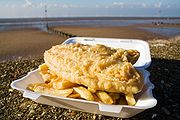 |
Fish and chips Fish and chips Fish and chips is a popular take-away food in the United Kingdom, Australia, New Zealand and Canada... is a widely consumed part of English cuisine, and is symbolic of England. |
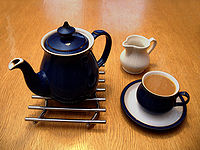 |
Tea Tea Tea is an aromatic beverage prepared by adding cured leaves of the Camellia sinensis plant to hot water. The term also refers to the plant itself. After water, tea is the most widely consumed beverage in the world... is symbolic of England. In 2006, a government sponsored survey confirmed that a cup of tea constituted a national symbol of England. |
Famous People
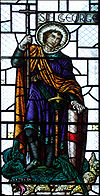 |
Saint George Saint George Saint George was, according to tradition, a Roman soldier from Syria Palaestina and a priest in the Guard of Diocletian, who is venerated as a Christian martyr. In hagiography Saint George is one of the most venerated saints in the Catholic , Anglican, Eastern Orthodox, and the Oriental Orthodox... is the patron saint Patron saint A patron saint is a saint who is regarded as the intercessor and advocate in heaven of a nation, place, craft, activity, class, clan, family, or person... of England. |
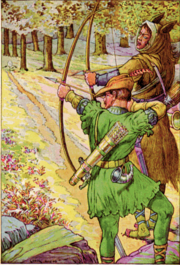 |
Robin Hood Robin Hood Robin Hood was a heroic outlaw in English folklore. A highly skilled archer and swordsman, he is known for "robbing from the rich and giving to the poor", assisted by a group of fellow outlaws known as his "Merry Men". Traditionally, Robin Hood and his men are depicted wearing Lincoln green clothes.... is a heroic outlaw Outlaw In historical legal systems, an outlaw is declared as outside the protection of the law. In pre-modern societies, this takes the burden of active prosecution of a criminal from the authorities. Instead, the criminal is withdrawn all legal protection, so that anyone is legally empowered to persecute... in English folklore English folklore English folklore is the folk tradition which has developed in England over a number of centuries. Some stories can be traced back to their roots, while the origin of others is uncertain or disputed... . |
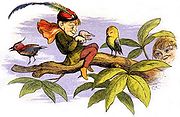 |
Elves Elf An elf is a being of Germanic mythology. The elves were originally thought of as a race of divine beings endowed with magical powers, which they use both for the benefit and the injury of mankind... and other mythological creatures such as pixie Pixie Pixies are mythical creatures of folklore, considered to be particularly concentrated in the areas around Devon and Cornwall, suggesting some Celtic origin for the belief and name.They are usually depicted with pointed ears, and often wearing a green outfit and pointed... s and fairies often appear in childrens book of fairytales based on English folklore. |

